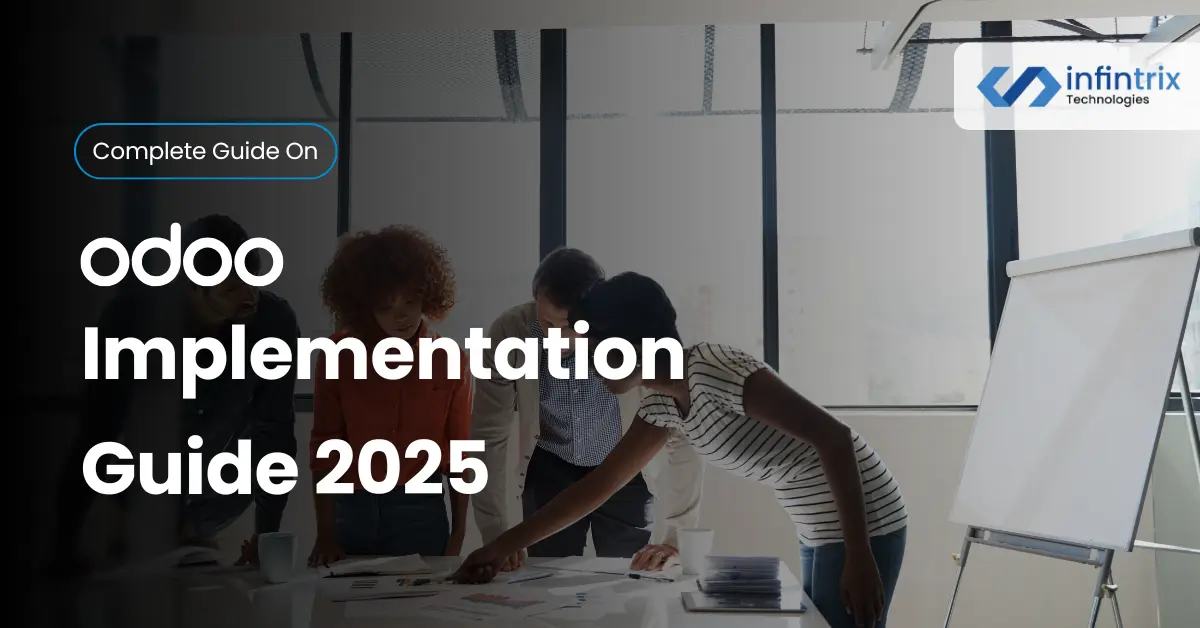In today’s fast-changing business environment, managing operations across sales, inventory, accounting, and HR with separate tools feels like juggling too many balls at once. By 2025, more organizations are turning to Odoo ERP for a single, integrated system that connects every department — giving leaders the visibility and control they need to grow.
This Odoo ERP implementation guide walks you through what matters most: the process, timeline, and cost. Whether you’re a business owner exploring digital transformation or an IT manager planning your first rollout, you’ll find clear, experience-based insights drawn from real implementation projects.
Why Odoo ERP Implementation Matters in 2025
Modern businesses run on data. Yet too often, that data lives in silos — spreadsheets, legacy accounting software, or separate CRM tools. The result? Duplicate entries, delayed reporting, and decisions made on incomplete information. That’s where ERP implementation comes in.
Unlike many platforms, Odoo brings all your operations together — CRM, inventory, accounting, HR, and manufacturing — inside one flexible system. It’s open-source, scalable, and built to evolve with your company. But success doesn’t come from installation alone; it depends on how you implement it.
What Makes Odoo ERP Unique for Modern Businesses:
- Modular design: Add or remove modules as your business evolves — from Sales and Inventory to HR and Manufacturing.
- Deployment options: Choose Odoo Community (open-source) or Odoo Enterprise (licensed with advanced features).
- Cloud or on-premise flexibility: Ideal for companies with different IT preferences or compliance needs.
- Lower total cost of ownership (TCO): Compared to traditional ERP systems, Odoo offers powerful functionality at a fraction of the cost.
The Role of Proper Planning in ERP Success:
Successful ERP rollouts don’t start with code — they start with clarity. A well-structured project plan defines your business processes, goals, and resources early on. Without this foundation, even the best ERP systems struggle to deliver ROI.
As experienced consultants at Infintrix Technologies (Odoo Partner in Pakistan) often emphasize, strong planning prevents scope creep, misalignment, and post-launch disruptions.
The Odoo Implementation Process: A Step-by-Step Approach
Every ERP project is unique, but the Odoo implementation process typically follows a proven structure. This step-by-step approach ensures your system aligns with your business — not the other way around.
Step 1 – Identify Business Needs & Define Objectives
Start by mapping your current workflows and pinpointing inefficiencies. Conduct a gap analysis to identify where automation or integration can make the biggest impact. Define measurable goals, such as faster invoicing or improved inventory accuracy.
Checklist:
- Document current processes (sales, procurement, finance).
- Identify system gaps and redundancies.
- Set clear KPIs for success.
- Engage stakeholders across departments early.
Step 2 – Select the Right Odoo Edition (Community vs. Enterprise)
Choosing between Odoo Community and Odoo Enterprise depends on your project scope and support needs.
| Feature | Odoo Community | Odoo Enterprise |
| Licensing | Free (Open Source) | Paid with official support |
| Features | Core modules only | Advanced modules (Accounting, HR, Studio) |
| Hosting | Self-hosted | Cloud (SaaS) or On-premise |
| Support | Community-based | Official Odoo & Partner Support |
For growing businesses, Odoo Enterprise often offers faster deployment and built-in maintenance — reducing long-term costs.
Step 3 – Planning & Partner Selection
At this point, it’s essential to work with a qualified Odoo implementation partner. A trusted partner guides configuration, ensures proper data handling, and aligns the system with your workflows.
For example, Infintrix Technologies has helped mid-sized manufacturers in Pakistan implement Odoo modules incrementally — starting with Accounting and Inventory, then expanding to CRM and HR. This phased approach minimizes disruption and ensures steady user adoption.
Step 4 – Configuration, Customization & Data Migration
Here’s where the system takes shape. Your consultant configures standard modules and performs necessary customizations. Next comes data migration — transferring existing records safely and accurately into Odoo.
Key actions:
- Configure modules based on daily operations.
- Customize forms, workflows, and reports.
- Migrate data from legacy systems.
- Validate data accuracy through pilot testing.
Step 5 – User Training, Testing & Go-Live Support
Once your system is configured, it’s time to test and train. User Acceptance Testing (UAT) ensures everything works as intended before the go-live phase.
Teams should receive hands-on training focused on real-world tasks — like creating sales orders, approving expenses, or running payroll. After go-live, continuous support ensures users stay confident and productive.
Odoo Implementation Timeline: What to Expect
One of the first questions most businesses ask is, “How long does Odoo implementation take?” The answer depends on factors like project complexity, data migration, and the number of modules involved.
For smaller organizations, implementation may take a few weeks; larger enterprises may require several months due to integrations and custom development.
Typical Timelines by Project Scale:
| Business Size | Estimated Timeline | Notes |
| Small Businesses (SMEs) | 4–8 weeks | Standard setup with minimal customization |
| Mid-sized Companies | 2–4 months | Multi-department rollout, moderate data migration |
| Large Enterprises | 4–6 months+ | Extensive modules, third-party integrations |
Factors That Affect Implementation Speed:
- Business readiness: Clear goals and data preparation accelerate progress.
- Customization complexity: More customization = longer timeline.
- User training: Adequate training ensures faster adoption.
- Integration requirements: Connecting with existing tools (CRM, POS, or payroll) can extend project time.
That said, working with an experienced Odoo Partner like Infintrix Technologies often streamlines this entire process — helping clients balance speed with quality implementation.
Odoo Implementation Cost: 2025 Breakdown
Every organization wants a clear picture of what ERP implementation will cost — and rightly so. Transparency around expenses helps set realistic expectations and supports better project management.
In 2025, the Odoo implementation cost varies widely depending on your company size, chosen edition (Community or Enterprise), and the number of modules you deploy.
Core Cost Components Explained
| Component | Description | Typical Range |
| Licensing Fees | Subscription or user-based fees for Odoo Enterprise | Starts from per-user pricing |
| Implementation | Configuration, customization, testing, and deployment | Based on project scope |
| Hosting | On-premise server setup or Odoo Online (SaaS) | Monthly or yearly |
| Support & Maintenance | Post-launch updates, issue resolution, monitoring | Retainer or hourly |
These are baseline elements; additional modules, data migration, or advanced features like multi-company accounting may increase total cost.
Estimated Cost by Business Type
A small service company may spend $2,000–$8,000, while a large enterprise could invest $30,000 or more, especially when integrating with third-party software. The total cost of ownership (TCO) should include licensing, implementation, and ongoing support.
Hidden Costs and Long-Term Value
Some expenses are less visible but equally important:
- Upgrades and enhancements as new versions release
- Change management and retraining after go-live
- Infrastructure and hosting adjustments
- Continuous improvement for long-term ROI
Working with a transparent implementation partner like Infintrix Technologies (Odoo Partner in Pakistan) helps clients manage these factors proactively — no hidden surprises, no rushed decisions.
Common Implementation Challenges and How to Overcome Them
Even the best ERP systems can struggle if the implementation is poorly managed. Understanding these pitfalls upfront saves time, money, and frustration.
1. Misaligned Objectives or Lack of Ownership
When departments operate in silos, ERP goals can drift apart. Every project needs a dedicated project owner who understands both business needs and technical priorities. Regular status reviews keep the implementation process aligned with strategy.
2. Over-Customization Risks
Custom features can be powerful, but too much customization often slows updates and complicates maintenance.
Avoid these mistakes:
- Adding unnecessary modules or scripts
- Ignoring upgrade compatibility
- Skipping documentation
3. Inadequate Training & Post-Go-Live Support
ERP adoption isn’t just about technology — it’s about people. Without proper training, employees revert to old processes. Reliable post-go-live support keeps momentum high and ensures ongoing improvement.
That’s why trusted partners like Infintrix Technologies invest heavily in user workshops, hands-on testing, and follow-up sessions to strengthen adoption.
Best Practices for a Smooth Odoo ERP Implementation
Through years of consulting experience, one truth stands out: ERP success isn’t luck — it’s preparation. Here’s how leading organizations ensure a smooth Odoo implementation from start to finish.
Build a Dedicated ERP Implementation Team
Your internal team is as crucial as your implementation partner.
Checklist:
- Appoint a clear project manager
- Involve key process owners (Finance, HR, Inventory)
- Assign technical leads for integrations
Start Small and Scale Gradually
Rather than deploying every module at once, begin with high-impact areas — such as Accounting or Sales — and expand once users are confident. This approach shortens your implementation timeline and helps secure early wins.
Focus on Change Management & Training
ERP transitions affect daily routines. Open communication reduces resistance.
Tips for success:
- Explain the “why” behind the system change
- Offer hands-on training before go-live
- Encourage feedback during early use
Infintrix Technologies often helps clients implement in controlled phases — minimizing disruption while steadily building user confidence.
Why Choosing the Right Odoo Partner Matters
Selecting the right implementation partner can make or break your ERP project. Beyond technical skill, you need a team that understands business logic, industry workflows, and user behavior.
Benefits of Working with Certified Odoo Partners
- Access to official Odoo resources and updates
- Consistent methodology for each implementation phase
- Proven experience across industries
- Continuous support for troubleshooting and scaling
How to Evaluate Your ERP Implementation Partner
When choosing your partner, look beyond price. Evaluate experience, methodology, and commitment.
Checklist for selection:
- Verify Odoo certification and past projects
- Ask about their project management process
- Review post-launch support and SLA options
- Request client references for similar industries
For example, Infintrix Technologies, a certified Odoo Partner in Pakistan, has delivered ERP projects for manufacturers, retailers, and service firms — each tailored to the client’s unique business processes.
Conclusion: Building a Future-Ready Business with Odoo ERP
Implementing Odoo ERP isn’t just an IT upgrade — it’s a business transformation. When executed properly, it centralizes data, reduces manual work, and enables smarter decision-making.
The key lies in structured planning, strong leadership, and the right Odoo implementation partner. With expert guidance from teams like Infintrix Technologies, businesses in 2025 can streamline operations and build a foundation for growth, scalability, and long-term success.
FAQs About Odoo ERP Implementation
How long does Odoo ERP implementation take for small businesses?
Typically, 4–8 weeks for small companies with limited modules. Larger rollouts with custom integrations can extend beyond six months.
What’s the average cost of Odoo ERP implementation in 2025?
Costs range from $2,000–$30,000+, depending on modules, users, and customization. Always request a clear implementation cost breakdown before starting.
Can I migrate my existing data easily to Odoo ERP?
Yes — with proper data migration planning. Your Odoo Partner can map old fields, clean inconsistencies, and ensure data integrity.
Do I really need an official Odoo Partner for implementation?
Working with a certified Odoo implementation partner reduces risk and ensures compliance with Odoo’s best practices. Partners like Infintrix Technologies (Pakistan) also offer long-term support and upgrades.
What kind of support do I get after Go-Live?
Post-launch support typically includes issue tracking, system monitoring, performance tuning, and periodic user training to keep your ERP running smoothly.

